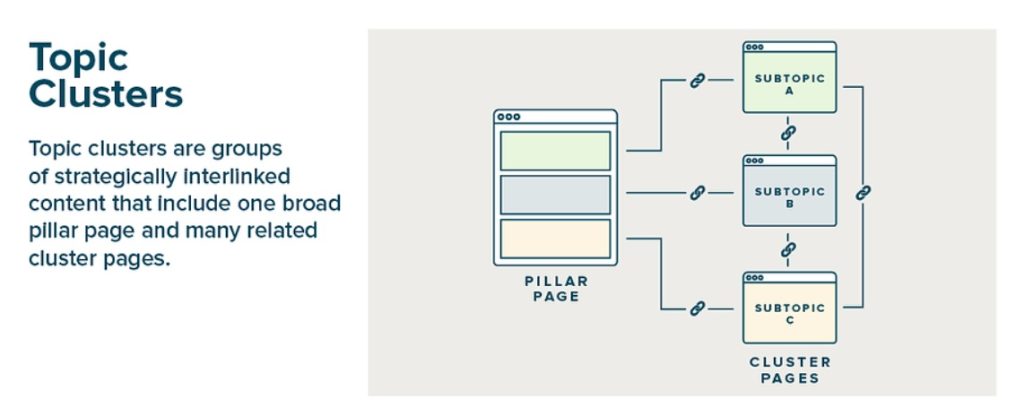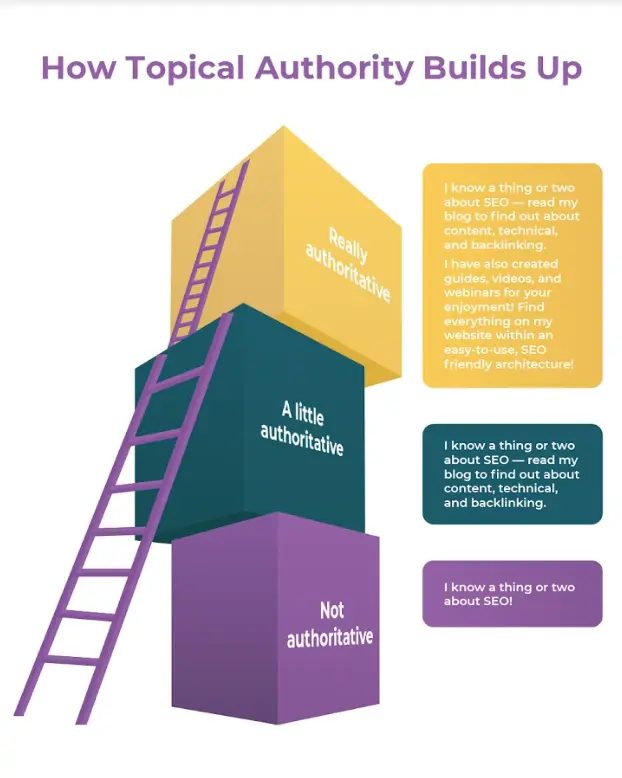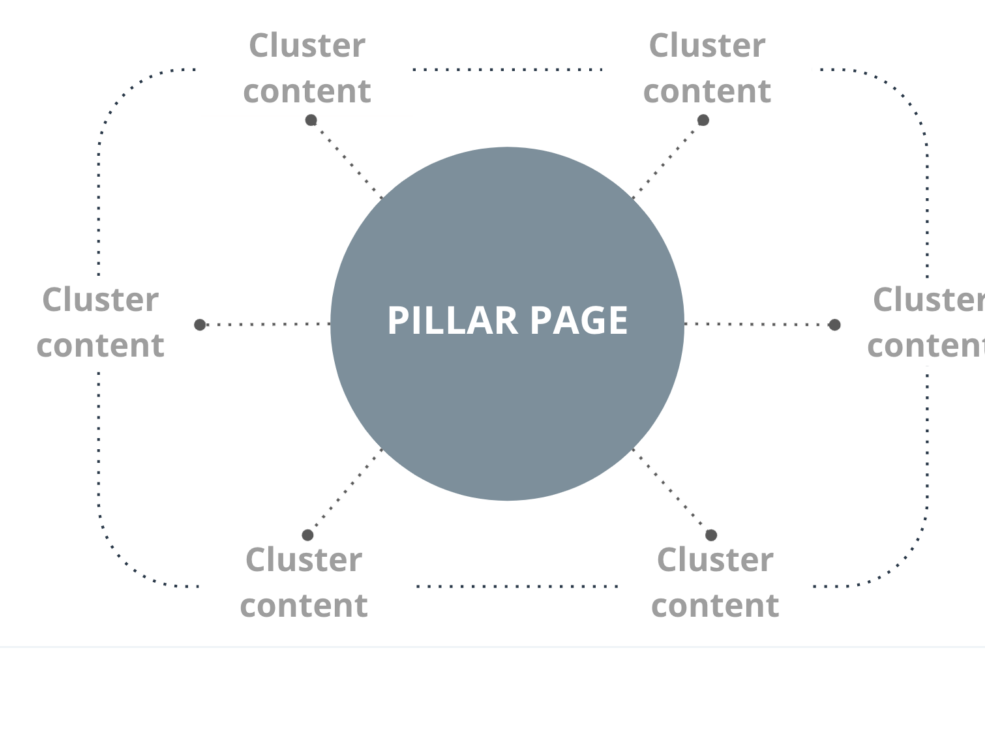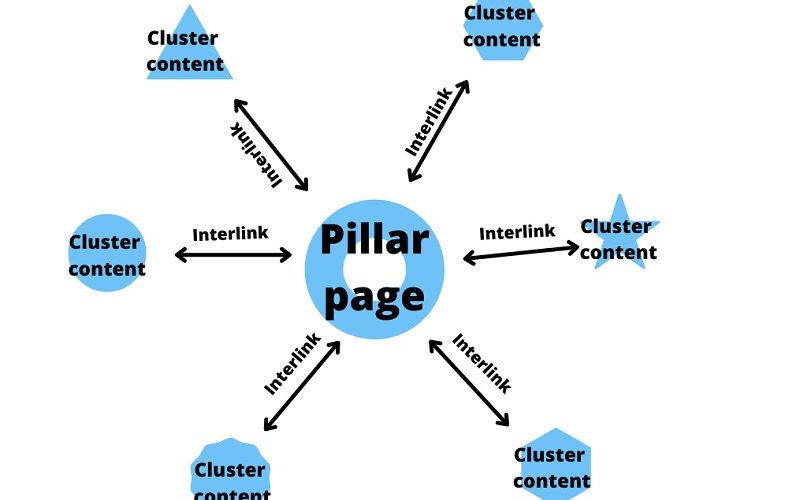When it comes to content marketing, establishing topical authority is crucial for achieving higher search engine rankings and becoming a trusted resource in your niche.
One powerful strategy to accomplish this is by using “cluster content” in conjunction with “pillar pages.”
In this comprehensive guide, we’ll explore the significance of cluster content and its role in supporting pillar pages within a topic cluster strategy.
Table of Contents
Content Clusters in a Topic Cluster Strategy
Search engines now prioritize content that demonstrates expertise, authority, and relevance on a given topic.
This is where the concept of a topic cluster content strategy comes into play.

At its core, it has two essential components: pillar pages and cluster content which are connected through internal links.
Pillar Pages are comprehensive, high-quality pages that serve as the cornerstone of your content strategy.
Each pillar page covers a broad topic within your niche, providing an in-depth overview and acting as a central hub for related information.
Cluster content, on the other hand, consists of a series of supporting articles that delve deeper into specific subtopics related to the pillar page.
Each cluster piece is tightly linked to the pillar page and other subtopics content, forming a cohesive network of interrelated information.
Content within a topic cluster serves as a fundamental building block in the construction of a successful SEO Content Strategy.
By comprehensively covering various facets of a subject, connecting content seamlessly, engaging users effectively, earning valuable backlinks, and showcasing expertise, supporting content empowers your website to claim its position as an authoritative voice in your niche.

Let’s explore each of these in detail;
Comprehensive Coverage
Content clusters act as supporting pages which allows you to comprehensively cover a topic by addressing various aspects and subtopics related to the main subject.
This depth of coverage demonstrates expertise and a deep knowledge of the field, reinforcing your site’s authority.
Internal Linking
Each piece in a content cluster is internally linked to the pillar page and vice versa.
This interconnected web of content boosts the overall SEO of your site, making it more attractive to search engines.
User Engagement
Cluster content enhances user engagement, as visitors can find detailed information on specific subtopics, which keeps them on your site longer.
Ultimately, a lower bounce rate signals to search engines that your content is valuable and relevant, positively impacting your rankings.
Building Backlinks
High-quality supporting content within a topic cluster can attract external backlinks, further establishing your website’s authority and credibility in the eyes of search engines.
Consequently, when other reputable websites link to your content cluster, it indicates that your web page is valuable and trustworthy, contributing to your site’s authority.
By offering detailed, expert-level insights on various aspects of a topic, cluster content helps you demonstrate your authority and expertise in your niche.
This builds trust with your audience and can lead to higher rankings in search results, solidifying your position as an authoritative source in your field.
How to Identify a Content Cluster Topic
Creating effective content clusters within a topic cluster begins with a strategic approach to identifying the right subtopics that will bolster your pillar page’s authority.
Here are the essential steps:
1. Keyword Research
Begin your Topic cluster strategy with thorough keyword research.
Look for related keywords, phrases, and questions that people frequently search for within the broader topic covered by your pillar page.

For this step, free keyword tools like AnswerThePublic, and premium SEO tools such as Ahrefs, or SEMrush can help you discover relevant keywords that indicate user interest.
2. Content Gap Analysis
Analyze your existing content library to identify gaps or subtopics that haven’t been sufficiently covered.
Seek areas where additional information or a deeper dive could provide real value to your audience.
These gaps often represent opportunities to create supporting content that complements your pillar page.
3. User Intent Assessment
Understanding the intent of users is crucial when selecting cluster topics.
Consider what specific questions or aspects users are exploring when searching for information related to your pillar topic.
This helps you choose relevant cluster topics that cater to their needs, enhancing user satisfaction and engagement.
4. Competitor Analysis
Study the content landscape within your niche, including what your competitors and authoritative sources are covering.
Identify the subtopics they’ve addressed and assess whether there are opportunities to create better, more informative cluster content.
Look for gaps or areas where you can provide a unique perspective or more comprehensive information.
Best Tips When Creating Content Clusters
Creating effective content clusters is not just about producing articles; it’s about delivering valuable, cohesive, and well-structured information that resonates with your audience.

In this section, we’ll explore essential tips and best practices for creating cluster content pages that strengthen your website’s topical authority and engage your readers effectively.
Alignment of Content with Pillar Page Theme
It’s important to ensure that each piece of content cluster directly supports and aligns with the main pillar page’s topic and objectives.
To achieve this, maintain a clear and logical connection between your cluster content and the overarching pillar page.
Keyword Optimization
Perform thorough keyword research for each cluster article and incorporate relevant keywords naturally.
Additionally, ensure that the content is supplemented with relevant LSI queries that relate to the target queries.
This optimization not only enhances search engine visibility but also ensures that your content is discovered by users searching for specific information.
Approach the Cluster Content with a Unique Angle
When crafting each cluster article, strive to present a fresh perspective or unique angle on the subtopic.
Distinguish your content from what you’ve previously covered in your topic cluster by offering novel insights, real-world examples, or in-depth case studies.
This approach not only sets your supporting pages apart but also adds significant value to your audience’s understanding.
Comprehensive, Yet Focused Coverage
While the pillar page provides in-depth coverage of the main topic, it’s essential for each cluster article to strike a balance by offering comprehensive coverage of the subtopic.
Address the specific needs and questions of your target audience comprehensively, ensuring that no aspect remains unexplored.
This approach both showcases your expertise and also keeps your audience engaged and informed.
Employ Optimal Internal Linking Strategies
Ensure the implementation of effective internal linking between your cluster content and the pillar page.
By doing so, you establish a seamless and interconnected content structure, simplifying navigation for users and aiding them in discovering related information.

Additionally, this strategic internal linking communicates the significance and authority of your content to search engines, bolstering your search visibility and credibility.
Common Mistakes to Avoid When Creating Cluster Content
Up to this point, you’ve gained a clear understanding of how to identify subtopics for your content clusters and implement best practices when writing.
However, it’s equally essential to recognize and avoid common mistakes that can compromise the effectiveness of your topic cluster strategy.
By being vigilant and avoiding these common pitfalls, you can ensure that each supporting piece of content not only complements your pillar pages, but also contributes effectively to your overall topical authority strategy.
1. Lack of Relevance
The core purpose of cluster content is to support and enhance your pillar page’s authority on a particular topic.
Failing to maintain this relevance can result in a disjointed user experience, confusion, and diminished topical authority.
2. Keyword Stuffing
While incorporating keywords is essential for SEO, overloading your cluster content with keywords in an unnatural manner can harm readability and user experience.
This includes not only the primary target keyword but also LSI (Latent Semantic Indexing) phrases that expand on the main keyword.
Consequently, keyword stuffing can easily make your content appear spammy and less trustworthy to both users and search engines.
3. Thin Content or Shallow Content
Users today expect comprehensive and informative content.
Creating cluster articles that lack depth or substance not only fails to meet these expectations but also hinders your ability to establish authority in your niche.

Too shallow content may also result in higher bounce rates and lower engagement.
4. Ignoring User Intent
Failing to address the intent of your target audience by neglecting to address their specific questions and needs can lead to mismatched content.
Therefore, always align your cluster content with user intent to provide valuable information that resonates with your readers.
CONCLUSION
Topic cluster strategy is a valuable strategy for enhancing your website’s overall topical authority.
It not only provides depth and breadth to your content but also strengthens your site’s overall SEO, user engagement, and credibility in your niche.
By strategically creating and linking cluster content to your pillar pages, you can establish yourself as an authority in your field in the long run, and attract a larger and more engaged audience.



